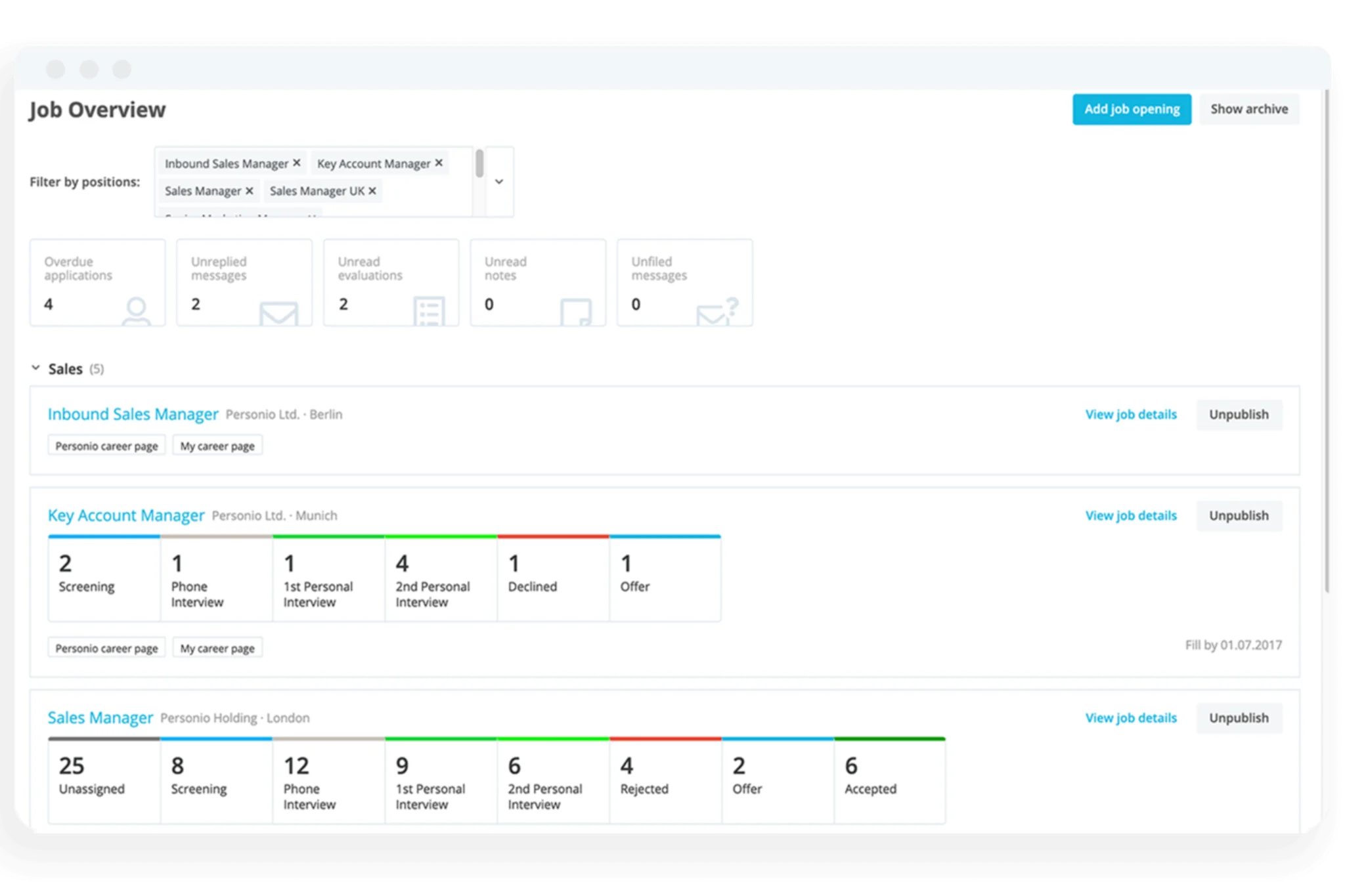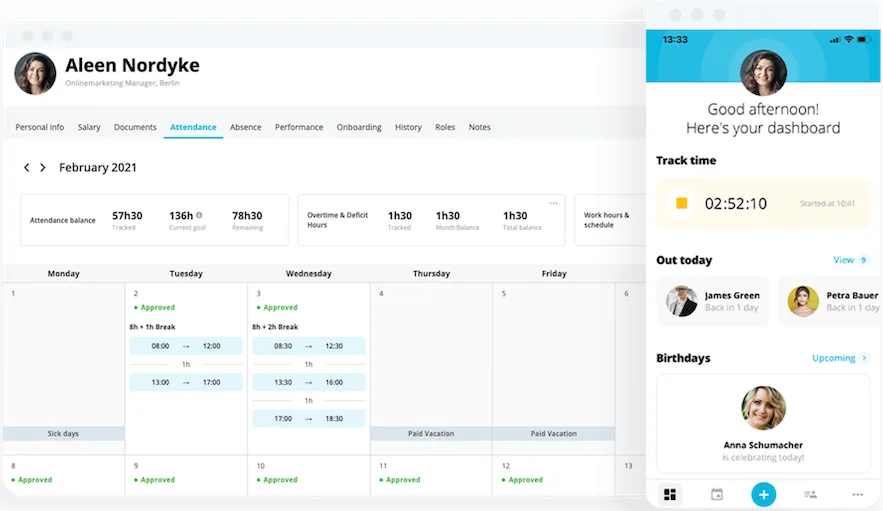Social Media Recruiting – Benefits, Tips and Best Practices

All paths lead to social media – and this also applies to recruiting. Social media recruiting has become a popular way to find employees. For this, you will need a good plan, expert knowledge and perseverance. In this article, we give you a practical, step-by-step guide on how to proceed.
Personio allows you to publish job postings on several portals with just one click. Find out all the details here.What Exactly Is Social Media Recruiting?
The term social media recruiting covers all HR marketing initiatives in which companies use social networks. Popular platforms include Facebook, Twitter, Instagram and YouTube, as well as career networks such as XING and LinkedIn. Discussion forums or services that are only well-known in specific industries are also included.
Social media recruiting includes "passive" initiatives such as maintaining a career portal as well as moderating online communities and actively searching for and addressing candidates. The special features of recruitment via social media include the ability to communicate quickly and easily with candidates and the chance to build up a large network of contacts.
Methods
In principle, using social media for recruitment involves exactly the same methods as other recruiting channels – the only difference is that they take place over social networks. This includes:
Active sourcing: You select suitable candidates for a position based on the data that they reveal about themselves in social networks. You target these candidates directly and try to persuade them to apply for your open position.
Content marketing and employer branding: You regularly publish content – texts, images, videos – on your social profiles to get the attention of your target group and sharpen your brand as an employer. The content must be precisely tailored to your target group. This ebook explains exactly how this works.
Referral marketing/influencer marketing: You build up strong networks with employees, customers, business partners and others. You try to take advantage of the reach of well-known, influential users (“influencers”) in your markets. These networks make it easier for you to reach a wider audience and recruit new hires through referrals.
Career pages and job postings: You make your career portal directly available in social networks (and/or link your career page to the networks) and publish your job postings there. You can reach a lot of potential candidates through the paid campaigns and online ads that many platforms offer.
Benefits
Recruiting through social media has a number of benefits that make it unique as a recruiting channel:
You can address your target group in an informal setting, in a place where they spend their free time.
This brings you into contact with candidates who are not, or are only passively, looking for a new job and would be unlikely to read any job ads.
You can build up an image of being an attractive employer relatively quickly, especially among younger target audiences.
Based on the data that social networks provide about their users, you can preselect suitable candidates and address them directly.
If you publish content that a lot of users like and share, you could “go viral” and quickly reach a very wide audience.
You can keep a close eye on how successful your activities are and use this information to make better decisions in the future.
Challenges
As with any new method or technology, you will need to overcome a number of challenges to successfully attract new hires through social networks:
Different target groups are present on different platforms – you have to find the right one for your company. Some target groups do not use social media at all or do not wish to be contacted by companies in this context.
Most users do not see social networks as part of their working environment, so you need to approach them in a way that is appropriate for this context: be entertaining and creative, and make sure your approaches are personalized, fast and direct.
You should ensure that your application and selection processes (like your semi-structured interviews) are suitable for social networks. Complicated and laborious processes are a no-go!
You need expert, specialist knowledge to master the new technologies and hold your own in the battle for user attention.
You will need to involve marketing, PR and, ideally, all your employees in this and coordinate how they work together.
Communication errors can have a negative impact and damage your image.
Data protection in social networks is a very complex topic.
Seven Steps to Successful Social Media Recruiting
Do not just post “anything” or hope users will spontaneously share your PDF job profiles. Make and follow a step-by-step plan.
Develop a Strategy
Analyze your workforce planning and your targets. Consider how using social media to recruit employees can and should help you achieve these targets. Define these sub-targets precisely, ideally in terms of your KPIs.
Example: In July, we want to write to 50 people on LinkedIn via active sourcing. Our goal is for 5% of them to respond positively to our message.
Select suitable platforms where you will be able to reach your target groups. Take your internal resources into account and start with the platforms that promise the greatest success, such as LinkedIn.
Set Up Processes
A successful social media recruiting strategy requires a lot of participants who can work well together. So, right from the start it is important that you clarify questions such as:
Who does what? Who is responsible for which decisions?
How are you going to communicate directly with users?
Who needs to approve which content?
Link your application processes directly to social networks, and if necessary, invest in new applicant management software. Throughout the process, candidates will expect the kind of quick and direct communication that they are used to from social media.
Define Communication Guidelines
Create clear guidelines on how your employees should communicate on social media in terms of language style, which words should or should not be used (“corporate wording”) and how candidates should be addressed.
It is particularly important that employees know how to react in critical situations: for example, if a user becomes insulting, tells lies about the company or if a former employee complains about the company.
Remember that different platforms will require different styles of communication. You should probably address users differently on Facebook than on XING.
Create a Professional Online Presence
Use the different options afforded by each network to create attractive profiles or company pages. Make sure that potential candidates can find you and will get a positive first impression when they do. Adapt the visual appearance of your profiles to your corporate identity.
Maintain your data. Find out how the search functions of each individual platform work and optimize your profiles so that you can be found with the search terms that are important to you.
Publish Content Regularly
You will need to keep publishing new content in order to remain visible. Create a detailed editorial plan for your use of social media recruiting tools. The content and frequency of your postings needs to suit the respective platform and target group – you should be posting photos or videos several times a day on media such as Instagram!
Be creative, tell exciting stories and have them produced in high quality. You need to entertain the user and get their attention, but at the same time, do not lose sight of your recruiting targets. Use your Marketing department's expertise here.
Actively Involve Your Employees
Your employees are the best possible ambassadors for your company. They will speak (hopefully) positively about your company, recommend friends as new hires and can provide input for new content.
As part of your onboarding process, for example, you could explain to your employees how to maintain their personal profiles and communicate on social networks. Reward referrals or have your employees give testimonials for your recruiting campaigns.
Actively Try to Reach a Wider Audience
The days when exciting content went viral all by itself are unfortunately over. Only very few campaigns become a hit and are shared millions of times. Actively maintain your profiles, run regular campaigns and, above all, make sure that your social media recruiting initiatives link in with your other marketing initiatives in order to multiply their effect.
Paid online ad campaigns are a good way to quickly reach a wide audience and get your content noticed.

Best Practices for Your Social Media Recruiting
Are you ready to get started? To help you get the most out of your activities, here are five expert tips for five different social media platforms.
✓ Facebook is a platform for getting together with friends and passing the time. All the content you post there should be short and to the point, as well as being entertaining and informal. Above all, post photos and (live) videos. Posts that only contain text or links are shown to Facebook users significantly less (due to the algorithm) and do not reach a wide audience.
✓ Publish at least one post per day, otherwise you will be lost in the flood of content.
✓ Place paid ads to reach more potential candidates. The best thing to do is to hire a specialized agency that can optimize your ads for the highest possible click-through rates, or get the support of your Marketing department.
✓ Remember to thank for reactions and comments and answer questions – ideally within hours! That is what users expect. It is important to see communication on Facebook as part of your recruiting process.
✓ Maintain your company profile and your personal profile as a recruiter. Candidates should be able to identify you immediately and get a professional first impression.
✓ Use the advanced search filters to find candidates who meet your selection criteria, for example, industry, career level or previous employer. Go over candidate profiles in detail and only contact candidates who would be a really good fit.
✓ Always send individual, personalized messages to candidates rather than sending out a standard text en masse. This approach has the greatest chance of receiving a positive response.
✓ Stay in touch with your contacts with regular messages, even if they are currently not eligible for a position. A strong network is absolutely essential for every recruiter!
✓ Publish your content when users are most active. The best times are Tuesdays to Thursdays, in the mornings from around 7:00–10:00 am and in the afternoons from around 4:00–6:00 pm.
✓ Post photos and short videos several times a day. Videos are especially popular. Create standard formats for your posts that users can recognize and that will make you stand out from the rest of their feed, for example a “tip of the day” or employee portraits.
✓ Make sure your posts always adhere to your corporate design. A uniform color palette, certain visual elements or a discreetly placed logo are good options.
✓ Use Instagram Stories: These are image or video series that are only available for 24 hours. They are extremely popular. For example, you could organize a “story takeover,” with one employee taking over your account for 24 hours and reporting live about their working day.
✓ Write an entertaining, meaningful description for each post. Include additional information, maybe even a link to your website and hashtags.
✓ Always respond to comments. After all, you are looking for potential candidates!
YouTube
✓ Approach video production professionally and invest in developing your concept and any equipment you may need. Because target groups have very exacting requirements when it comes to video content and quality.
✓ Present your company authentically and credibly. Do not spend time producing glossy videos. And you do not need to be desperately creative: If your employees do not generally like to sing and dance, you should not force them to do so in a video.
✓ Let your employees speak. Potential applicants are interested in real insights into your company, and your employees’ views count for more than any advertising message.
✓ YouTube is the largest search engine for videos. Optimize your video itself, the title and the description for YouTube and Google searches.
✓ Place paid ads that will appear on other users’ videos. YouTube offers detailed targeting options that you can use to determine your target group.
Disclaimer
We would like to inform you that the contents of our website (including any legal contributions) are for non-binding informational purposes only and does not in any way constitute legal advice. The content of this information cannot and is not intended to replace individual and binding legal advice from e.g. a lawyer that addresses your specific situation. In this respect, all information provided is without guarantee of correctness, completeness and up-to-dateness.


